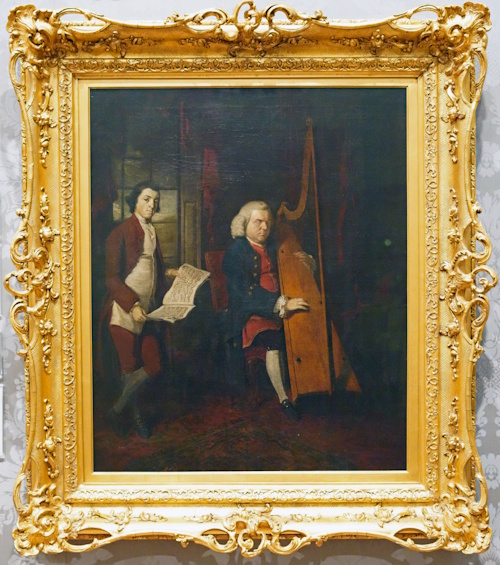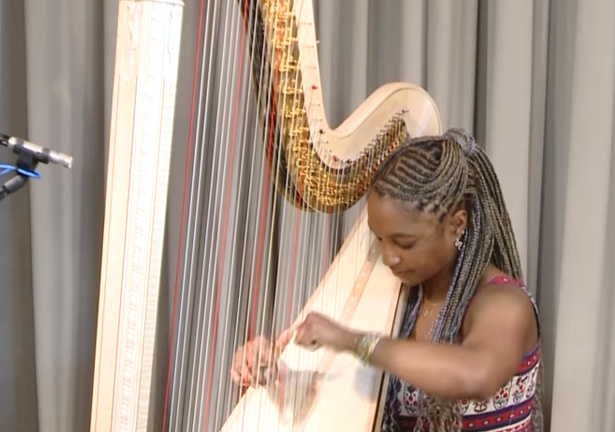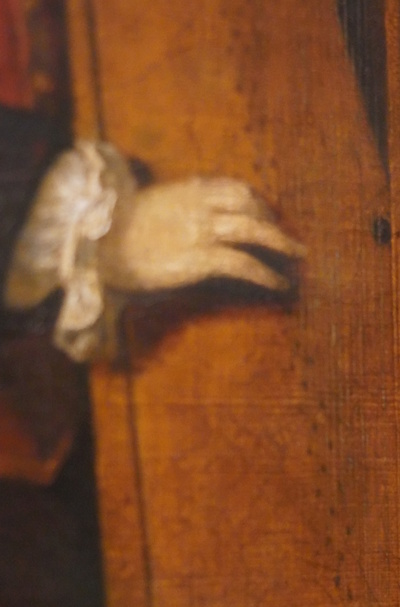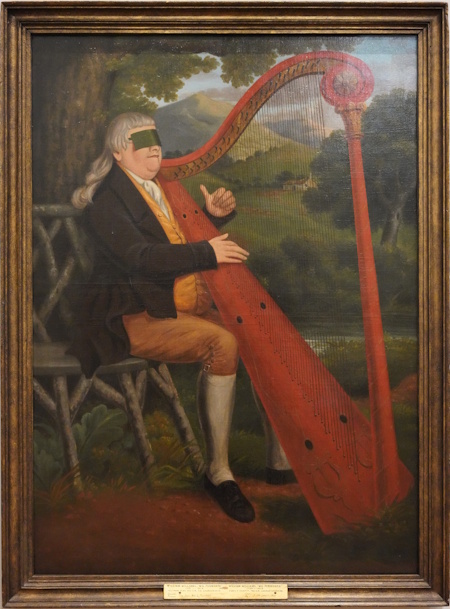 The Blind Harpist by William Parry |
A façade of doric columns, the National Museum Cardiff references Greek and Roman temples. In truth, the National Museum Cardiff is a small-scale version of many museums I have known, like the Philadelphia Museum of Art, The Metropolitan Museum of Art, the Museum of Fine Arts in Boston, or the Art Institute of Chicago. It is a dwarf in comparison to the British Museum or the Louvre. That hasn’t diminished my affection for the National Museum Cardiff. It hasn’t kept me from acquiring a lifetime membership to Friends of National Museum Wales.
It is so much like a temple, whether for a god, or palace for a divine leader, or a mausoleum for the dead who are still treasured, you don’t build like this unless to contain something sacred. This space exceeds what is needed for living. Tall front doors and the high ceilings are wasted space for human needs. You cannot fill the space with your body, but your spirit rises freely and feels liberated, unconstrained, to be uplifted and overwhelmed. You have been invited to associate with the sacred.
The museum is a fifteen-minute stroll from home. I visit it often. During my most recent visit, I saw a painting that I have probably seen before, but I didn’t remember it, had obviously not given it sufficient regard. This is often true. An appreciation of things is improved by the attention you bring to study it. My education and memory are not equipped to appreciate everything, but from time-to-time doors of perception open in my mind and I get to see a thing in a way I haven’t seen it before. This happened with The Blind Harpist by William Parry, an 18th century oil on canvas.
My curiosity was prodded by a recent email exchange the week before. My friend Skip sent a music video for me to watch, declaring, “Here's an instrument that we haven't had much of in our back and forth.” The video was Ashley Jackson performing Take Me to the Water on a harp.

Ashley Jackson
I emailed back to him, “You did know, didn't you, that the harp is the national instrument of both Ireland and Wales?” He knew about the Celtic harp, evident on every pint of Guinness stout and that it was the national instrument of Ireland, but he didn’t know that another kind of harp was the Welsh national instrument.
It was only in the last few years that somewhere, somehow, I picked up the knowledge that the Welsh harp has three rows of strings. I then had to research it because I could not understand how fingers could reach the middle strings if they were blocked by strings on either side. The strings are mounted in a diagonal array and not side-by-side. Not many people play the Welsh harp these days. The triple string harp began life in Italy, reaching London in the 17th century, but that is where Welsh musicians fell in love with the instrument and adopted it.
So, now I was leaning in very close to William Parry’s painting, inspecting the arrangement of the strings.

Much to my delight, the strings were not in a single row. They were in fact in three rows. The label beside it on the wall made no mention of this. I knew the three rows signified that this was the Welsh harp. I wanted to tell someone, that being my nature. But wouldn't that just be showing off? I contained myself. At least I tried. But....
As I was departing, a small museum guard wearing a hijab asked if everything was alright. My face must have been projecting the inner frustration. I busted out with my discovery and then apologized, explaining this uncontrollable urge that needed venting. She was very sweet and understanding about it. In addition to that, she actually expressed interest. Her name was Ali. She wanted to see it for herself.
I led her back to the painting and pointed out the details I had noticed. Ali suggested I should fill out a form at the front desk enlightening the museum and suggesting that that information be included in the label. Considering that the museum is interested in all things Welsh, surely this tidbit would be regarded as important. But I didn’t want to seem like a pedant, even if that is probably what I am.
Ali then told me there was another painting of another blind harpist in the next room. She led me to it.

Will Penmorfa
This second oil painting on canvas was Will Penmorfa by J. Chapman. This painting from the 19th century was of another blind harpist. Sure enough, he was also playing a Welsh harp with three rows of strings.

I was thrilled and shared this with Ali. Again, she felt strongly that I should fill out the form that would correct the matter. She, like me, felt that this information was special.
So, I did. On the way out, I approached the front desk and they gave me a Visitor Feedback form. It covered complaints, corrections, advice, and compliments. I sat down at a table in the café in the main hall and composed my thoughts. As I made my way back to the front desk, there was Ali speaking with an associate. I showed her the paper, proof that I had done as she had instructed.
The story doesn't end there. Later that night, I looked for the paintings online to see what more I could learn about them. Wikipedia had the painting of Will Penmorfa by J. Chapman. Whoever wrote the description commented that Chapman was not a good draughtsman because he drew the harp's strings wrong. For the first time ever, I edited information on the Wikipedia page.
![]()
Mr Bentzman will continue to report here regularly about
the events and concerns of his life. If you've any
comments or suggestions, he would be pleased to hear from you.
You can find his
several books at www.Bentzman.com.
Enshrined
Inside Me, his second collection of
essays, is now available to purchase.
